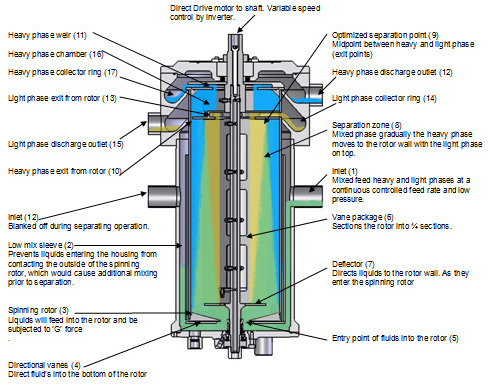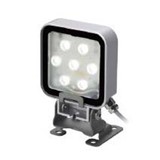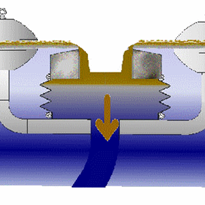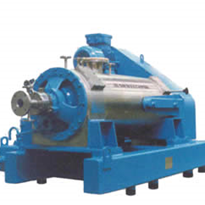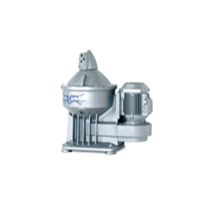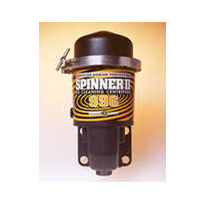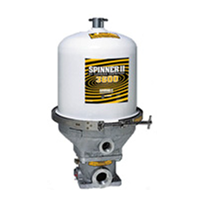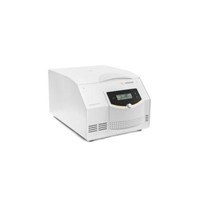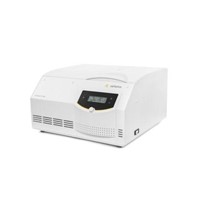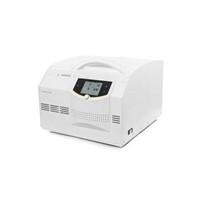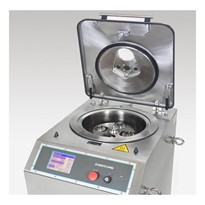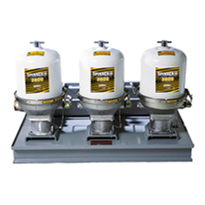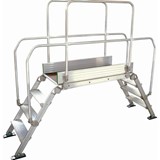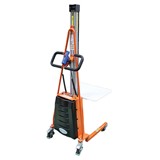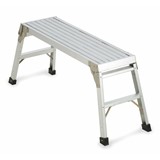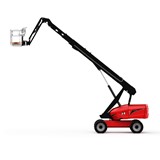Liquid/ liquid dispersions that require hours to separate at 1"G" can be greatly enhanced both in speed and efficiency at 200 "G".
There are four basic operational functions of the centrifuge. The set up differs slightly for each of the process’s which are:
- Separations
- Extractions and water washes (Mixing and separation)
- Multi stage, gravity fed, continuous counter current Extractions
In order to conduct a separation using equipment from CINC SOLUTIONS you should familiarise yourself with the function of the low mix sleeve and how the unit optimizes the separation at the top of the rotor on fixed light phase weir, before separating by the designated discharge outlets.
Mixed liquids of any ratio and with differing Specific Gravities are continually pumped (low pressure) or gravity fed into one of the inlets (1) provided on the housing (the spare (12) is blocked off). During separations, a sleeve (2) (low mix sleeve option) is installed to protect the liquids entering the housing from contacting the spinning rotor (3) (and therefore preventing further mixing before separating). The liquids, after entering the housing drop to the base plate of the centrifuge, which has directional vanes (4) that direct the liquids to the entry point (5) at the base of the spinning rotor.
Inside the rotor at the base of the vane package (6) a mild pumping action takes place to continually fill the rotor at the pre determined feed rate. As the liquids are entering the spinning rotor they contact with a deflector plate (7), which forces the mixed liquids to the outside of the rotor wall at the bottom of the rotor. At this point the mixed liquids are first subjected to the "G" force created by the spinning rotor. As the unit is continually fed the liquid gradually and continually moves up the inside of the rotor sleeve and is subjected to centrifugal force between 100 "G" to 600 "G" inside the separation zone (8). The internal height of the rotor is significant, as this, along with the liquid flow rate fed to the unit will determine the length of time (the retention time) the liquids are subjected to "G" force and are therefore en hanced to be an efficient separation. The slower the unit feeds, the longer the liquids remain in the rotor, the longer they are subjected to "G" force, the better the separation efficiency. This is significant if liquids have specific gravities that are close together or are emulsified and are subsequently difficult to separate.
Light and Heavy Phase Discharge
During the period of retention the mixed phases inside the spinning rotor are subjected to the " G " forces and two distinct phases will appear inside the rotor. The heavy phase will move toward the rotor wall and the light phase will settle on top of the heavy phase. When the two, now separate phases reach the top of the rotor they optimize at the centre of the "Fixed" light phase weir (9). At this point the now separated phases are able to exit the top of the rotor for discharge. There are 4 heavy phase exit points at the top of the rotor (10) which allow the heavy phase liquid to enter the top heavy phase chamber (16) past the pre determined changeable heavy phase weir (11) and out through the heavy phase discharge outlet (12). The light phase will gradually separate from the heavy phase and sit "on top" as both liquids spin in the rotor. As both phases reach the fixed light phase weir (9) the optimum separation point, is its centre. This is the optimum separation point at which physical separation takes place sending the two separated phases into different discharge outlets in the housing.
Evidence of carryover exiting a phase discharge can be corrected by adjusting the motor RPM. Whilst it is recognised the optimum separation position is the centre of the fixed light phase weir allowing both phases to exit the required discharge there may be occasions when ratios of phases dictate slight adjustment of this position are required. Slight increase or decrease of the motor speed will increase or decrease the amount of "G" force inside the unit. This will effect the position of the optimum separate phase on the fixed light phase weir (9), moving this phase to or from its exit point by increasing or decreasing the motor speed and can be used to adjust the unit in order to prevent carryover.
As the rotor continues to fill from the bottom the light phase volume at the optimum point will exit from the light phase exit (13) into the light phase collector ring (14) and out via the light phase discharge outlet (15). The heavy Phase exits the rotor at point (10), up into the heavy phase chamber (16) out into the heavy phase collector ring (17) and discharged out of the heavy phase discharge outlet (12).
Applications
|
Environmental Industry |
|
|
Biotech Industry |
|
|
Mining and Metals Recovery Industry |
|
|
Food and Nutrition Industry |
|
|
Chemical Industry |
|
|
Pharmaceutical Industry |
|
|
Petroleum Industry |
|
|
Bio diesel Production |
|


